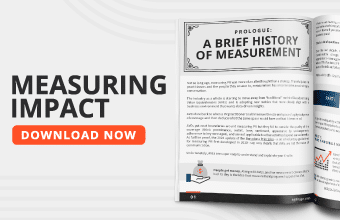What to measure in PR is often the million-dollar question when it comes to launching an external communications strategy. The answer is not easy: some believe that PR impact is impossible to measure, while others rely on widespread metrics such as number of clicks, reach or ad equivalency, which have the advantage of simplicity but provide little context. There are other more meaningful measurements out there, we just have to shift focus from output to impact, always referring back to the objectives and strategy at play.
Before measuring, analyze
Before jumping into the ring and setting up PR goals, it is always advisable to take a step back and invite companies and brands to analyze where they are starting from. If they have just arrived to a new market they could and should do audience research, understand what competitors are doing, what kind of stories are gaining traction, how, where and when.
If a company or brand already has a presence in the market, what does it look like? What opportunities have been well exploited—news, events, thought leadership—and what white spaces and areas of opportunity still exist in the short, medium and long-term?
All this is crucial for two reasons: in order to not saturate media and other channels with the same sort of information they already receive from others, and in order to ensure you are uniquely positioning a company or brand to set it apart from competitors.
Seeing the challenges that our clients face when trying to define roadmaps in new markets, Speyside Group have designed a tool called in.sight that analyzes the current landscape, identified areas of opportunity and provides recommendations based on local realities. When you have all this information it is easier to create a clear strategic roadmap and set key and measurable PR objectives and metrics that can evolve over time…
Content as a pillar
A one-size-fits-all approach to measuring content does not make sense. One needs to consider the objective, audience, channels and how the content will translate across a wide variety of different platforms.
That’s why we do not recommend just focusing on the ‘number of clippings’ obtained or the ‘Ad Equivalency’ value, but rather which messages you want to target to which audience and what action or response you are trying to drive in each case. If it was a content aimed at doctors, did it reach publications that they read, even if there are few in the market? If it is a content inviting them to take part in a food promotion, did it reach the target demographic and drive sign ups on the customers’ website?
In order to set up the best metrics for content impact we must consider what the audience cares about. All brands believe that their story is extremely interesting. But the reality is that it is not always. So whoever writes the content must take a step back and think about what the audience they want to reach cares about, what informs, educates and entertains them and how to tell the right story in the right tone always keeping in mind the brands’ call. Let’s remember that we are competing with an ocean of information and that no one wants to read advertising but meaningful stories.
And how do you measure impact?
There are many PR strategies beyond content that we could mention here. But the important thing to keep in mind is that we should not always use the same metrics. Public Relations are “relationships”, so there are many other aspects that are not always tangible but that give an account of the success of a strategy.
For example, are you having the opportunity to share relevant news with your potential customers, are they commenting on those? Is the PR area listening to the business area to understand what those customer pains are and using this to find out what external audiences are looking for? Is the local media looking for your spokespeople? Are published news being shared and commented? Are shared materials such as ebooks being downloaded?
There are many ideas for measurement you just have to make sure you are looking for the rights ones.








